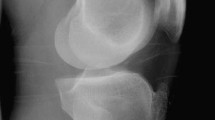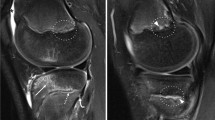Abstract
Objective
To assess the relationship between low- and high-grade subchondral insufficiency fracture of the knee (SIFK) and meniscal tear/type/location, severity of meniscal extrusion, grade of chondrosis, and extent of surrounding edema-like marrow signal intensity.
Materials and methods
Our retrospective study included 219 patients with knee pain and SIFK seen on MRI. SIFK lesions were categorized from grade 1 to 4 with a low grade (1 and 2) vs high grade (3 and 4) distinction. Associations between SIFK grade, location, lesion dimensions, edema-like marrow signal intensity, incidence of meniscal tears/type/location, and chondrosis (grade 0 to grade 4), as well as patients’ age and weight, were assessed.
Results
Our analysis consisted of 115 males and 104 females with 17% of the patients showing grade 1 SIFK, 59% grade 2, 16% grade 3, and 8% grade 4. No chondrosis or low-grade chondrosis was mostly present in patients with low-grade SIFK (68.9%), whereas high-grade chondrosis was mostly present in patients with high-grade SIFK lesions (65.4%) (p < 0.01). Further sub-analysis demonstrated that high-grade SIFK was associated with high-grade chondrosis in the same compartment (p < 0.01) but not in the adjacent compartment. There was a significant difference in the extent of edema-like marrow signal intensity between the two groups, with high-grade SIFK more frequently demonstrating severe edema-like marrow signal intensity compared to low-grade SIFK (p < 0.01).
Conclusion
High-grade SIFK lesions are associated with unicompartmental high-grade chondrosis.




Similar content being viewed by others
Abbreviations
- SIFK:
-
Subchondral insufficiency fracture of the knee
- SONK:
-
Spontaneous osteonecrosis of the knee
- MRI:
-
Magnetic resonance imaging
- ROC:
-
Receiver operating characteristic
References
Ahlback S, Bauer GC, Bohne WH. Spontaneous osteonecrosis of the knee. Arthritis Rheum. 1968;11(6):705–33.
Sayyid S, et al. Subchondral insufficiency fracture of the knee: grading, risk factors, and outcome. Skelet Radiol. 2019;48(12):1961–74.
Yamamato T, Bullough PG. Spontaneous osteonecrosis of the knee: the result of subchondral insufficiency fracture. J Bone Joint Surg. 2000;82(6):858–66.
Karim AR, et al. Osteonecrosis of the knee: review. Ann Transl Med. 2015;3(1):6.
Hussain ZB, et al. The role of meniscal tears in spontaneous osteonecrosis of the knee: a systematic review of suspected etiology and a call to revisit nomenclature. Am J Sports Med. 2019;47(2):501–7.
Lotke PA, Ecker ML. Osteonecrosis of the knee. J Bone Joint Surg Am. 1988;70(3):470–3.
Yasuda T, et al. Association between medial meniscus extrusion and spontaneous osteonecrosis of the knee. Int J Rheum Dis. 2018;21(12):2104–11.
Sung JH, et al. Meniscal extrusion and spontaneous osteonecrosis with root tear of medial meniscus: comparison with horizontal tear. Arthroscopy. 2013;29(4):726–32.
Fabricant PD, Jokl P. Surgical outcomes after arthroscopic partial meniscectomy. J Am Acad Orthop Surg. 2007;15(11):647–53.
Koshino T. The treatment of spontaneous osteonecrosis of the knee by high tibial osteotomy with and without bone-grafting or drilling of the lesion. J Bone Joint Surg Am. 1982;64(1):47–58.
Nelson FR, et al. Subchondral insufficiency fractures and spontaneous osteonecrosis of the knee may not be related to osteoporosis. Arch Osteoporos. 2014;9:194.
Li G, et al. Subchondral bone in osteoarthritis: insight into risk factors and microstructural changes. Arthritis Res Ther. 2013;15(6):223.21.
Troeberg L, Nagase H. Proteases involved in cartilage matrix degradation in osteoarthritis. Biochim Biophys Acta. 2012;1824(1):133–45.
Lotke PA, Abend JA, Ecker ML. The treatment of osteonecrosis of the medial femoral condyle. Clin Orthop Relat Res. 1982;171:109–16.
Wilmot AS, et al. Subchondral insufficiency fracture of the knee: a recognizable associated soft tissue edema pattern and a similar distribution among men and women. Eur J Radiol. 2016;85(11):2096–103.
Viana SL, Machado BB, Mendlovitz PS. MRI of subchondral fractures: a review. Skelet Radiol. 2014;43(11):1515–27.
Acknowledgements
The authors would like to thank Yara Younan and Monica Umpierrez for their dedicated support with this work.
Author information
Authors and Affiliations
Corresponding author
Ethics declarations
Competing interests
The authors declare no competing interests.
Additional information
Publisher’s note
Springer Nature remains neutral with regard to jurisdictional claims in published maps and institutional affiliations.
Rights and permissions
About this article
Cite this article
Allam, E., Boychev, G., Aiyedipe, S. et al. Subchondral insufficiency fracture of the knee: unicompartmental correlation to meniscal pathology and degree of chondrosis by MRI. Skeletal Radiol 50, 2185–2194 (2021). https://doi.org/10.1007/s00256-021-03777-w
Received:
Revised:
Accepted:
Published:
Issue Date:
DOI: https://doi.org/10.1007/s00256-021-03777-w




